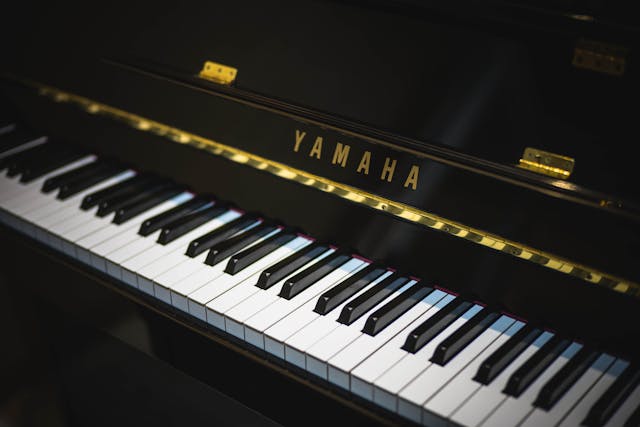Today at GertieBlu, we’re striking the keys on one of the most beloved instruments in the world: the piano. Whether you’ve always dreamed of learning or are simply curious about how it works, this guide will give you the basics to get started. The piano’s versatility opens the door to a rewarding journey into the world of music.
Why Learn the Piano?
The piano is unique in its ability to create both melody and harmony, making it a perfect standalone instrument or a great accompaniment to other instruments and voices. It’s also fantastic for beginners because its layout is logical and easy to grasp. Plus, learning piano builds a solid foundation in music theory that applies to virtually any other instrument.
Now, let’s break it down step by step: from the keys to posture to your first notes!
The Layout of the Piano
A standard piano has 88 keys, with 52 white keys and 36 black keys. The white keys are labeled from A to G in a repeating pattern, while the black keys are grouped in twos and threes, which makes it easy to navigate.
White Keys: Natural Notes
These represent the natural notes—A, B, C, D, E, F, G. Once you hit G, the cycle repeats back to A.
Black Keys: Sharps and Flats
The black keys play the sharps (#) and flats (♭) of the white keys. For example, the black key between C and D can be called C# (C sharp) or D♭ (D flat).
To easily find Middle C, the home base for many beginners, look for a group of two black keys. Middle C will be the white key directly to the left of the group near the center of the piano.
Proper Posture and Hand Position
Before you start playing, getting your posture and hand positioning right is essential for both comfort and technique.
- Posture: Sit up straight with your feet flat on the floor. Your arms should be parallel to the ground when you place your hands on the keys. You should not have to stretch or strain to reach any part of the keyboard.
- Hand Position: Curve your fingers slightly, as though you’re holding a small ball. Your thumbs should rest on the white keys, and each finger should fall naturally onto its own key. This will allow you to move smoothly and prevent tension.

Learning the Notes: Simple Exercises
One of the first things you’ll learn is how to identify the notes on the piano and become familiar with their placement.
Exercise 1: Find Middle C
Find Middle C using the method we mentioned earlier. Play it a few times with your right thumb (this will be Finger 1).
Exercise 2: C Major Scale
The C Major Scale is an excellent starting point because it uses only white keys. It goes as follows: C-D-E-F-G-A-B-C. Here’s how to play it:
- Right Hand: Start with your thumb (Finger 1) on C, then place the next fingers on D, E, F, and G (Fingers 2-5). When you reach G, tuck your thumb under to continue up to A, B, and finish on C again.
- Left Hand: Reverse this, starting with your pinky (Finger 5) on the lower C and working up toward your thumb.
Basic Chords: The Building Blocks of Songs
Once you’re comfortable with notes, you can begin to learn chords, which are simply groups of notes played together. The most common type of chord is a triad, which consists of three notes.
Example: C Major Chord
The C Major Chord is made of the notes C, E, and G. Play these three notes together, with your thumb on C, middle finger on E, and pinky on G.
Once you’ve mastered the C major chord, you can try playing others, like G Major (G-B-D) or F Major (F-A-C).
Reading Music: Treble and Bass Clef
Music is written on a staff, which consists of five lines and four spaces. For piano, you’ll read both the treble clef (right hand) and the bass clef (left hand).
- Treble Clef: Usually played with your right hand, it includes higher notes. Notes on the treble clef are E-G-B-D-F on the lines, and F-A-C-E in the spaces.
- Bass Clef: Played with your left hand, the notes are lower. The lines are G-B-D-F-A, and the spaces are A-C-E-G.
Learning to read music takes practice, but once you get the hang of it, it will open up a world of piano songs you can play.

Practice Makes Perfect
Like any new skill, playing the piano requires practice and patience. Start slow, repeat exercises, and gradually work your way up to more complex pieces. Even just 15-20 minutes of focused practice each day will show improvement over time.
Here are some beginner tips:
- Start Simple: Practice easy songs like “Twinkle, Twinkle, Little Star” or “Ode to Joy” to build confidence.
- Use a Metronome: This helps you keep time and develop your sense of rhythm.
- Be Consistent: Daily practice, even if short, helps build muscle memory and familiarity with the keyboard.
Final Thoughts
Learning the piano is a wonderful way to connect with music, and mastering the basics sets you on a path to explore everything from classical compositions to pop hits. Whether you’re playing for fun or looking to become more serious, these foundational steps will give you the tools you need to start your musical journey.
So, sit down at the keys, explore the sounds, and most importantly—have fun! 😊
GertieBlu—Sharing the magic of music, one note at a time. 🎶









